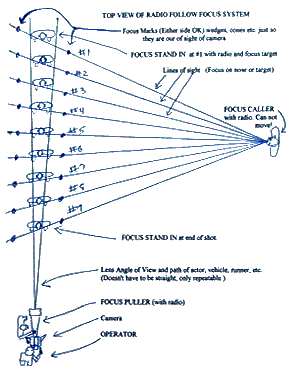Radio Focus Pulling
Some operators can pull their own focus with long lenses very well, but it is
difficult to watch performance and framing as well. Taking the focus worry away,
will make shot evaluation easier for the operator. Many assistants can do amazing
jobs of pulling focus, but the longer the lens the tougher it becomes. Here
is a system that anyone can learn and make almost every shot sharp with a long
lens, "IF" the subject path is repeatable. The focus puller needs only to look
at the lens and listen to the radio. Also consider the Preston Cinema Light
Ranger focus system that will make perfect focus under any situation.
What's needed:
1. A FOCUS CALLER with a radio. Someone once trained that can do it for the
rest of the job.
2. A FOCUS STAND-IN with a radio and 10 or more MARKS. Wedges work well. The
focus stand-in can be the AD because once the marks are made he is through.
A contrasty target is useful for focus. A shiny object in the sun works well
too. A large Siemans Star would be useful. (See Focus
Pattern)
3. A FOCUS PULLER with a radio and a good system to make marks on the lens.
He needs a radio and maybe headphones so that he can hear over the noise of
the camera once the real shooting starts.
4. An OPERATOR at the camera. (Can be focus puller or assistant)
5. A repeatable PATH for the action, the car, runner, biker or what ever is
being photographed. The FOCUS STAND-IN must be able to take this path.
6. Time to set up the marks.

The System
1. The director or operator determines the lens and PATH of the actor, car,
bike etc.
2. The focus caller is placed at right angles to that path, half way from start
to finish. The further the caller is away from the path, the less the parallax
error. Once in place he cannot move or new marks will have to be made.
3. The focus stand-in estimates or paces off the length of the path. This distance
is divided into 7 to 10 equal spaces between marks. (For some reason this number
works for most shots.)
4. The focus stand-in places the first mark (#1) out of sight of the camera,
but in view of the focus caller. The mark should be as close to the actor's
path as possible, either side is all right. The caller confirms that he can
see the marks. The operator can also confirm that he does not see the marks
in camera.
5. The focus stand-in paces off and leaves a mark at #2. He checks with the
operator and focus puller if the spacing is not too close or too far apart.
He then places marks #3,4,5,etc.
6. The stand-in goes back to #1. The caller places him in line with mark #1,
with hand signals or radio. The caller says "on 1" by radio.
7. The operator focuses on the stand-in, tells the focus puller when he has
it.
8. The puller tells the stand-in "go to 2" as he makes the #1 focus mark. The
puller might recheck the mark with the operator before he sends the stand-in
to the next mark.
9. The caller adjusts the stand-in lined up to mark #2 by radio and says on
the radio "on 2". The operator focuses, puller marks and so on.
10. The stand-in can walk or run the path for a test as the caller calls, the
puller focuses and the operator watches for focus with the lens wide open. If
all is well you are ready to shoot. If either the caller, or puller thinks he
is off, he should tell the operator when he thinks he was off. Another try will
confirm if there really is a problem when all think they are "on" their marks.
11. The caller should call "ready... and ...one... and ... two ... and three...
etc." "And" is half way between marks.
12. As you are shooting, the caller and puller should try to remember when they
were off their marks to help determine if the marks are OK or someone is just
off their mark.
The focus puller / assistant can also do the focusing if the operator is not
available, it just takes a little longer. He has to make each mark before sending
the stand-in to the next mark.
A separate channel on the radio is useful. CB headset communicators are OK if
there is no local interference. The puller has to hear the marks when the camera
is rolling. Good earphones help.
A system to expand the lens focus scale to a larger diameter is helpful. Easy
to see and change marks are helpful too.
This system will work using existing reference points such as broken white lines
on the pavement, guard rail posts, or light poles. Often the caller can describe
and number the existing marks. The operator then focuses on the reference points
for when the actor, car etc. will pass that point.
In high noise level places like airports, ear phones are a must.
© Copyright 1999-2004 Ron Dexter. All Rights Reserved.

